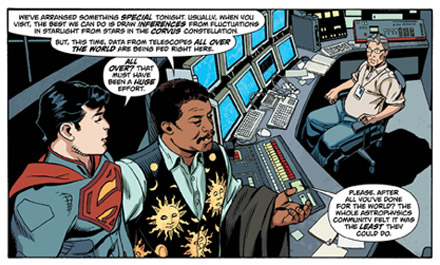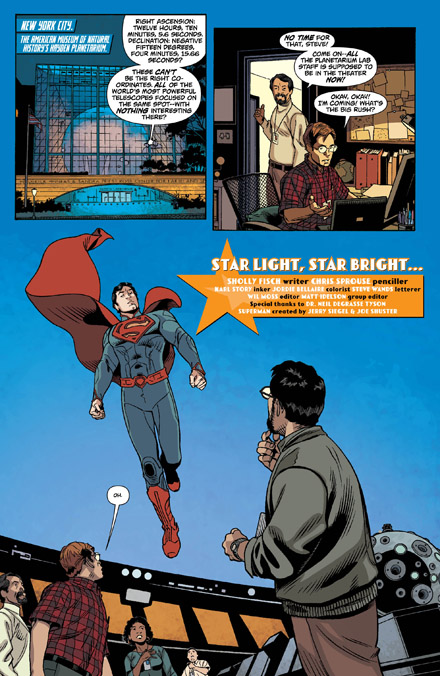 As both a scientist and a Superman fan, there was one story that DC Comics published in 2012 involved both Superman and Neil deGrasse Tyson... where Neil helped Superman see the last light from the exploding planet Krypton.
As both a scientist and a Superman fan, there was one story that DC Comics published in 2012 involved both Superman and Neil deGrasse Tyson... where Neil helped Superman see the last light from the exploding planet Krypton. - There is a cool 6 minute video that explains how the story came together, too (see below).
- Rob
Here's the story of how it came to be from the American Museum of Natural History:
Action Comics #14, published in November 2012 by DC Comics, reveals that even Superman visits the Museum’s Hayden Planetarium—and not just to see the Space Show.
The superhero, it turns out, comes once a year to see images of his far-off home planet, Krypton, said to orbit its home-star every 382 days. To locate the fictional planet in the actual sky, DC Comics worked with astrophysicist Neil deGrasse Tyson, director of the Museum’s Hayden Planetarium. “When an artist’s muse leads to scientific themes,” says Tyson, “we are there to help out.” Tyson elaborates on the process in this video.
VIDEO ON HOW THE STORY HAPPENED: https://youtu.be/uZYLN_Ouu5U
CAPTION: During a roundtable discussion with journalists, Hayden Planetarium Director Neil deGrasse Tyson explains how he helped Superman find his home planet of Krypton. Tyson appears as a character in the recent DC Comics' ACTION COMICS #14, "Star Light, Star Bright." In real life, he consulted a star index and found a real star that supported the backstory of the comic. The red dwarf star designated for having the ability to support a Krypton-like planet is located in the constellation Corvus 27.1 light years from Earth. The star, designated LHS 2520, possesses a red, highly turbulent surface, somewhat cooler and smaller than the Sun. To find it in the night's sky, amateur astronomers and Superman fans can follow these coordinates: J2000
Right Ascension: 12 hours 10 minutes 5.77 seconds
Declination: -15 degrees 4 minutes 17.9 seconds
Proper Motion: 0.76 arcseconds per year, along 172.94 degrees from due north
FIRST TASK: TYSON DETERMINES KRYPTON ORBITED STAR LHS 2520 IN CORVUS CONSTELLATION
Tyson’s first task was to figure out where the planet Krypton would be located in the galaxy. Using the facts of Superman’s fictional life—such as his age, about 27—Tyson studied published catalogs of known stars to determine a few possible candidates about 27 light years from Earth, around which Krypton might orbit.
After hearing about the candidates, DC Comics homed in on one—a star known as LHS 2520—because it was within the night-sky constellation Corvus, which is Latin for crow. As Superman aficionados know, the mascot of Smallville High School—which Clark Kent attends growing up—is the Crow.
Back on Earth, astronomers don’t know whether LHS 2520 has any planets orbiting it. But over the past two decades, many astronomers have discovered planets orbiting stars other than our Sun. Though only a small portion of the sky has been surveyed so far, about 800 of these exoplanents have already been discovered, with thousands more observed but not yet confirmed.
Still, distant stars like LHS 2520 are not easily observed; in fact, no telescope today is strong enough to see details of planets as far off as the fictional Krypton would be. To actually see a planet 27 light years away, says Tyson, a telescope “would have to be the width of the Earth!”
Instead, today, exoplanet researchers mostly observe exoplanets indirectly, by watching the effects of a planet’s gravity on the star, or the tiny eclipses that occur as planets “transit,” or cross, a star.
But astrophysicists can combine the powers of telescopes placed at a distance from one another to amplify their powers of observation. Called interferometry, this method, for now, utilizes small telescopes, not powerful enough to observe far-off Krypton-like exoplanets.
SECOND TASK: TYSON DEVISES PLAUSIBLE METHOD BY WHICH SUPERMAN CAN SEE HIS FAR-OFF HOME
To make the comic’s key plot point—Superman observing his home planet’s destruction—scientifically plausible, Tyson combined fact with fiction. In the comic, every actual visible-light telescope on Earth observes Krypton at the same moment, in effect creating a massive interferometer—a feat only possible in comics.
Sadly for Superman, this amazing technology allows him to observe the long-ago explosion of his home planet, the light from which has taken 27 years to reach Earth. “The Planet Krypton has been gone for years,” reads the comic. “But as far as Superman is concerned—Tonight is the night Krypton died.”


